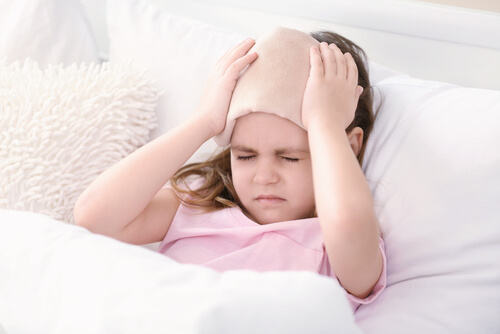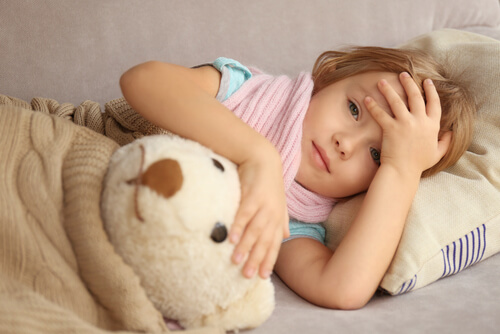What To Do If Your Child Has Bumped Their Head

What to do if your child has bumped their head
When this occurs, the first thing we tend to do is take our little one straight to the doctor, and there’s no fault in that.
But health professionals agree that after suffering a strong bump to the head, often the best thing a child can do is rest and take it easy.
However, there’s always someone around to insist that you shouldn’t allow your child to sleep or he could go into a coma. This type of advice can be terrifying for parents.
In reality, everything depends on the intensity of the impact or blow to the child‘s head.
If your child has hit their head, the first thing you should do is make sure they’re conscious. To do this, ask short and simple questions like: “What’s your name?”, “Where are you?” and similar.
If your child is too small to answer these questions, then you can can check your little one’s reactions to certain stimuli. This will allow you to evaluate if your child is conscious or not.
You can observe whether your child follows an object with his eyes as you move the object in front of him. You can do the same thing with a shining light.

Symptoms you should watch out for
The symptoms your child may display after bumping his head can vary, and some call for medical studies and observation.
When a child suffers a bump to the head, the brain may have been shaken. This can result in certain symptoms or reactions while the brain is getting itself back in order. This can take some time.
Among the most common symptoms are: Disorientation, loss of balance, blurry vision, headache, tingling in the arms and legs, and vomiting.
A medical professional should evaluate the duration and intensity of these symptoms to decide if hospitalization or medical studies are necessary.
What to do if there are no apparent symptoms?
If the child doesn’t present any symptoms and continues playing as normal after hitting her head, then there is probably no reason to worry.
Remember that, at this age, the bones in your little one’s body and even her skull have a certain flexibility that cushions and absorbs some of the impact.
If you child has minor head pain, you can offer an analgesic, but always with a recommendation and/or prescription from a trusted pediatrician. You can also place cold compresses on her forehead and have her take it easy for the rest of the day.
If your child wants to sleep, let her. Her body and her brain are demanding rest and relaxation. However, you should check on her often and wake her up at least every 2 hours to see how she reacts.
Of course, if your child hits her head very hard and you cannot control the wound, then you should seek medical assistance immediately.

Further advise for parents
First of all, remain calm. If your child is crying, try to calm him down as soon as possible. Often, bumps to the head are less serious than you imagine, even when there is heavy bleeding. Remember that the head has an infinite amount of blood vessels.
Furthermore, keep in mind that bumps to the head are one of the most common injuries that children sustain.
As your little one plays, runs, learns to walk, tries to reach something, falls off the bed, rides his bike, many of the bumps and bruises he sustains will be on his head.
Most of the time, these injuries are very minor. However, sometimes injury can be serious – especially when dealing with car accidents, skating accidents, or falls down the stairs.
It’s always best to be prudent and work to prevent, within reason, the risk of your child suffering any type of injury.
What to do if your child has bumped their head
When this occurs, the first thing we tend to do is take our little one straight to the doctor, and there’s no fault in that.
But health professionals agree that after suffering a strong bump to the head, often the best thing a child can do is rest and take it easy.
However, there’s always someone around to insist that you shouldn’t allow your child to sleep or he could go into a coma. This type of advice can be terrifying for parents.
In reality, everything depends on the intensity of the impact or blow to the child‘s head.
If your child has hit their head, the first thing you should do is make sure they’re conscious. To do this, ask short and simple questions like: “What’s your name?”, “Where are you?” and similar.
If your child is too small to answer these questions, then you can can check your little one’s reactions to certain stimuli. This will allow you to evaluate if your child is conscious or not.
You can observe whether your child follows an object with his eyes as you move the object in front of him. You can do the same thing with a shining light.

Symptoms you should watch out for
The symptoms your child may display after bumping his head can vary, and some call for medical studies and observation.
When a child suffers a bump to the head, the brain may have been shaken. This can result in certain symptoms or reactions while the brain is getting itself back in order. This can take some time.
Among the most common symptoms are: Disorientation, loss of balance, blurry vision, headache, tingling in the arms and legs, and vomiting.
A medical professional should evaluate the duration and intensity of these symptoms to decide if hospitalization or medical studies are necessary.
What to do if there are no apparent symptoms?
If the child doesn’t present any symptoms and continues playing as normal after hitting her head, then there is probably no reason to worry.
Remember that, at this age, the bones in your little one’s body and even her skull have a certain flexibility that cushions and absorbs some of the impact.
If you child has minor head pain, you can offer an analgesic, but always with a recommendation and/or prescription from a trusted pediatrician. You can also place cold compresses on her forehead and have her take it easy for the rest of the day.
If your child wants to sleep, let her. Her body and her brain are demanding rest and relaxation. However, you should check on her often and wake her up at least every 2 hours to see how she reacts.
Of course, if your child hits her head very hard and you cannot control the wound, then you should seek medical assistance immediately.

Further advise for parents
First of all, remain calm. If your child is crying, try to calm him down as soon as possible. Often, bumps to the head are less serious than you imagine, even when there is heavy bleeding. Remember that the head has an infinite amount of blood vessels.
Furthermore, keep in mind that bumps to the head are one of the most common injuries that children sustain.
As your little one plays, runs, learns to walk, tries to reach something, falls off the bed, rides his bike, many of the bumps and bruises he sustains will be on his head.
Most of the time, these injuries are very minor. However, sometimes injury can be serious – especially when dealing with car accidents, skating accidents, or falls down the stairs.
It’s always best to be prudent and work to prevent, within reason, the risk of your child suffering any type of injury.
All cited sources were thoroughly reviewed by our team to ensure their quality, reliability, currency, and validity. The bibliography of this article was considered reliable and of academic or scientific accuracy.
- Cortez, C. G. M., & Guillén-Pinto, D. (2021). Traumatismo encéfalo-craneano por caída libre en neonatos. Acta médica peruana, 38(3). https://doi.org/10.35663/amp.2021.383.2078
- Guillén-Pinto, D., Zea-Vera, A., Guillén-Mendoza, D., Situ-Kcomt, M., Reynoso-Osnayo, C., Milla-Vera, L. M., Bravo-Padilla, E., Espinoza, I. O., & Del Pilar Medina-Alva, M. (2014). Traumatismo encefalocraneano en niños atendidos en un hospital nacional de Lima, Perú 2004-2011. Revista Peruana de Medicina Experimental y Salud Pública, 30(4). https://doi.org/10.17843/rpmesp.2013.304.244
- Neira, A. G. B., Macera, S. P. H., Ordoñez, W. E. Z., & Conforme, W. A. D. (2019). Traumatismo Craneoencefálico: Importancia de su Prevención y Tratamiento. RECIMUNDO: Revista Científica de la Investigación y el Conocimiento. https://doi.org/10.26820/recimundo/3.(2).abril.2019.467-483
- Polacov, M., Malamud, B., Galetto, M., Blegini, M. (s.f.). Los pediatras decimos NO a los andadores infantiles. Sociedad Argentina de Pediatría Córdoba. www.sapcordoba.com.ar/novedades_ver.asp?id_noticia=1354
- Manrique, I., Alcalá, P., (2008). Manejo del traumatismo craneal pediátrico. Protocolos Diagnóstico Terapéuticos de la AEP: Urgencias Pediátricas. 2008 264-289. https://serviciopediatria.com/wp-content/uploads/2019/12/2008_Manejo-traumatismo-craneal-pedi%C3%A1trico.pdf
- Cantu, R., & Hyman, M., (2012). Concussions and Our Kids. Editorial Houghton Mifflin Harcourt. https://books.google.com.co/books?hl=es&lr=&id=OlSeiu6ia-cC&oi=fnd&pg=PP2&dq=fall+asleep+before+concussion+could+make+them+slip+into+a+coma&ots=8UR3XCZ5gK&sig=F-gwcjp_nUprDwjLSc_rqV1yw50&redir_esc=y#v=onepage&q&f=false
This text is provided for informational purposes only and does not replace consultation with a professional. If in doubt, consult your specialist.








